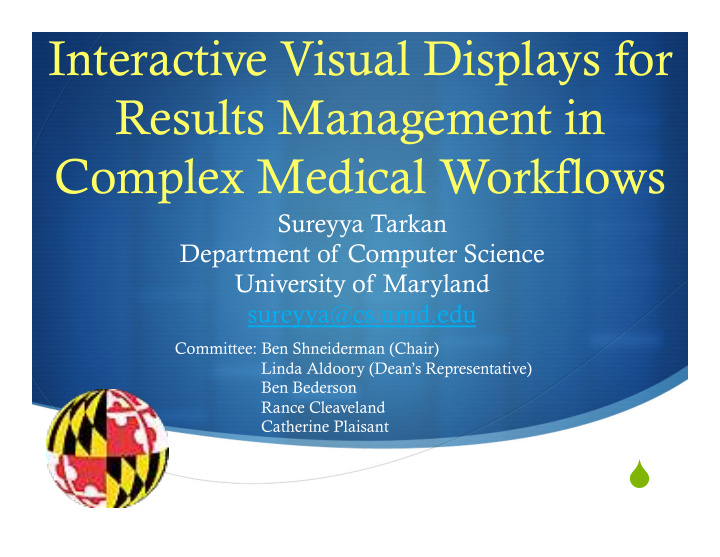



Interactive Visual Displays for Results Management in Complex Medical Workflows Sureyya Tarkan Department of Computer Science University of Maryland sureyya@cs.umd.edu Committee: Ben Shneiderman (Chair) Linda Aldoory (Dean’s Representative) Ben Bederson Rance Cleaveland Catherine Plaisant �
A story…
Missed Results Hickner, 2008; Phillips, 2004
Veterans Administration View Alert
OpenVista Follow-up
OpenVista Follow-up
OpenVista Follow-up
OpenVista Follow-up
Contributions ① Observations and interviews with clinicians and discussions of findings for results management ② Evaluations to quantify the benefits in time-critical applications where distractions undermine users’ ability to track and react to orders ③ The development of guidelines for interactive rich tables with actions for rapid completion (ARCs) ④ The design and user studies of a novel retrospective analysis visualization
Solution Physician, Resident, Manager Assistant …
Solution Physician, Resident, Manager Assistant …
Requirements Analysis Visits to 7 hospitals & clinics Observations of the medical workflow Electronic Health Record issues reported by clinicians Problems related to results management Design ideas about use cases, tables, delays, actions
Results Management Workflow & Actions [Aalst, 2005; Cass, 2000; Peterson, 1981; White, 2004]
Solution Physician, Resident, Manager Assistant …
Timely Management of Medical Orders: MStart
Timely Management of Medical Results: ARC
Evaluations Iterative Design Reviews with Medical Professionals Controlled Experiment for Awareness of Order Timeliness Evaluations of Actions for Rapid Completion
Iterative Design Reviews with Medical Professionals Participatory design [Greenbaum and Kyng, 1991] Medicine, human-computer interaction, or software engineering 40 or more clinicians 15 presentations + 6 meetings 30 mins to 2 h each Live demonstration or with interactive executable Nov, 2010 – Jun, 2011 & Jan – May, 2012
Iterative Design Reviews with Medical Professionals Feedback on guidelines and evaluation Suggestions from a graphic designer Refinements to results management workflow Updates to prototype interface and interactions Design of retrospective analysis visualization
Controlled Experiment for Awareness of Order Timeliness Quantify the benefit of showing a list of pending orders prioritizing by lateness information Compare 3 versions Time to answer question: what is late/lost?
Provide list of orders
A distraction task… �
Results only (sorted by time received)
Results only (sorted by time received) Which orders are late ? Lost ?
Results only (sorted by time received) (Compare with orders) Which orders are late ? Lost ?
Add pending orders (Compare with orders) Which orders are late ? Lost ?
Add pending orders (with lateness information) (Compare with orders) Which orders are late ? Lost ?
Results (18 participants)
Results (18 participants)
Predictive Model for Results Management Goals, Operators, Methods, and Selection rules (GOMS) [Card, 1983] Time to compare names ≈ 0.5 sec 2 < time to look up a date ≤ 2.5 3 ≤ time to compare dates ≤ 3.5
Evaluations of Actions for Rapid Completion Evaluating Time to Execute Actions Evaluating the Number of Steps
Conventional Follow-up
Evaluating Time to Execute Actions ★ Action Conventional ARC ARC w/ Keyboard Review Later 30s 28s (7%) 26s (13%) Inform Patient + 44s 39s (11%) 29s (34%) Confirm Inform Patient + 51s 42s (18%) 34s (33%) Repeat Test (1 mo) + Confirm Inform Patient + 1m 8s 51s (25%) 41s (40%) Schedule Visit (1 w) + Confirm No Follow-up 1m 2s 53s (15%) 49s (21%) (Other) + Confirm ★ Measured Difference: 10 orders w/o distraction
Evaluating the Number of Steps Action OpenVista Allscripts ARC Inform Patient - 6 3 (50%) Confirm - 5 2 (60%) No Follow-up - 4 4 (0%) Repeat Test 17 - 5 (71%) Schedule Visit 12 - 5 (58%)
Design Guidelines Results management design guidelines (8) Table design guidelines (65) Actions for rapid completion design guidelines (17)
Results Management Design Guidelines Show pending orders Prioritize by late/lost status Embed actions when appropriate Provide retrospective analysis
Table Design Guidelines Sample Current Design
Table Design Guidelines Sorting, icons, colors, columns, labels, filters, layout • [Few, 2004; MSCUI, 2008; Tullis, 2004]
Actions for Rapid Completion Design Guidelines
Solution Physician, Resident, Manager Assistant …
Retrospective Analysis of Medical Orders: MSProVis
Process Completion Diagram (PCD) 41
Process Completion Diagram (PCD) 42
Process Completion Diagram (PCD)
Multi-Step Process Visualization
Evaluation Usability studies Studies with 5 novices Studies with 2 physicians Surveys
Surveys Survey 1 Survey 2
Conclusion ① Observations and interviews with clinicians and discussions of findings for results management ② Evaluations to quantify the benefits in time-critical applications where distractions undermine users’ ability to track and react to orders ③ The development of guidelines for interactive rich tables with actions for rapid completion ④ The design and user studies of a novel retrospective analysis visualization
Conclusion Provider, Resident, Manager Assistant …
Recommend
More recommend